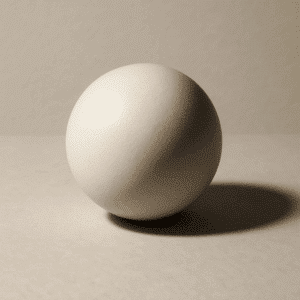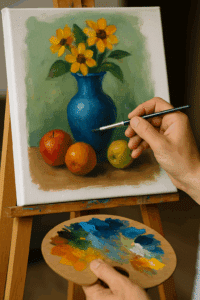

If you want your acrylic paintings to look more realistic and full of life, follow these simple steps to learn how to add depth and dimension effectively:
Pro Tip: Avoid using pure black for shadows — mix complementary colors to create natural, dynamic depth in your acrylic masterpiece.

A simple sphere under a single light source showing highlight, mid-tone, and cast shadow. AI
Every form interacts with light differently. Understanding this interaction is the foundation of shading. Each object has highlights, mid-tones, and shadows determined by its light source. By studying how light wraps around forms, you can guide the viewer’s eye and bring structure to your work in your quest to add depth.
Sketch your subject lightly, marking areas where light hits directly (highlights) and where it fades (shadows). This pre-painting map will keep your composition balanced and realistic, ensuring depth and dimension.
Color choice is key to achieving believable dimension. For example, when painting a red apple, don’t simply use black for shadows — try a deep green or rich brown instead to add depth organically.
Complementary colors enhance contrast and realism. Mixing them creates more natural depth and prevents muddy results, which is essential in acrylic painting.
Acrylics are perfect for blending, but they dry quickly, so timing is everything. Start with a base color, then add darker or lighter tones while it’s still wet to achieve a seamless depth in acrylics.
Use a clean brush or sponge to soften transitions between tones. The smoother the blend, the more lifelike and dimensional the result will be.
One of the greatest strengths of acrylic painting is layering. Once a layer dries, you can add another to enhance richness and build depth and dimension.
Apply thin, transparent glazes over dried paint to modify color intensity. This technique creates a luminous, multi-dimensional finish, vital in acrylic painting.

Observation is one of an artist’s most powerful tools. Use photos or real-life objects to study how light behaves. Notice where it reflects, softens, or disappears — and then incorporate these insights into your painting for added depth.
The more you paint, the better you understand the delicate balance between light and shadow. Practice with different subjects — from fruit to landscapes — and vary your light sources for new challenges in mastering depth and dimension.
Every painting teaches you something new. Don’t be afraid of bold contrasts, unusual color mixes, or unexpected results. Artistic growth thrives on exploration as you learn how to add dimension creatively.
At Yarnell School of Fine Art, we believe every artist has a unique voice waiting to shine. By learning how to add depth and dimension in acrylic painting, you can transform flat images into vibrant, three-dimensional works of art.
Grab your brushes, trust your instincts, and let light and shadow guide you — because the world is your canvas. Make it vivid, make it yours.